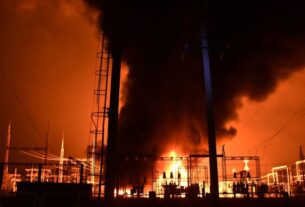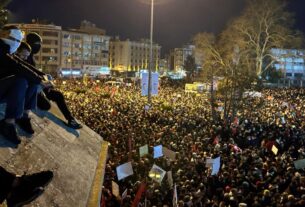Per Olsson is a member of Socialistiskt Alternativ (ISA in Sweden).
“We are drifting into one of the most dangerous periods in human history,” said the Director of the Stockholm International Peace Research Institute (SIPRI), when the Institute published its annual report (SIPRI Yearbook) on world military expenditure, international arms transfers, arms production and armed conflicts in June.
The report makes for scary reading. As a result of rising global tensions and the steady escalation of imperialist power struggles, both the risks of war and the world’s nuclear arsenals are increasing. “This elevated nuclear competition has dramatically increased the risk that nuclear weapons might be used in anger for the first time since World War II,” SIPRI researchers warn.
2022 was also a year in which the world’s total military spending reached a new record level, and the number of deaths in armed conflicts doubled last year, according to Uppsala Conflict Data Program (UCDP) at Uppsala University in June this year.
The need for a global fight against militarism and imperialism and for peace has never been greater. “Militarism must die if the people are going to live,” as the early socialist workers’ movement stated.
In 2022, global military spending increased for the eighth consecutive year, reaching a new record high of $US 2,240 billion, The amount spent on the world’s armed forces is equivalent to almost $US290 per person on earth.
Meanwhile, “The nine nuclear-armed states — the United States, Russia, the United Kingdom, France, China, India, Pakistan, the Democratic People’s Republic of Korea (North Korea) and Israel — continue to modernize their nuclear arsenals and several deployed new nuclear-armed or nuclear-capable weapon systems in 2022. Of the total global inventory of an estimated 12,512 warheads in January 2023, about 9,576 were in military stockpiles for potential use — 86 more than in January 2022.” (SIPRI, 12 June).
Booming War Industry
The world’s armed forces consume enormous resources. “At the top of the ranking for the world’s largest employers is India’s Ministry of Defence. Combining active service personnel, reservists and civilian staff, the total headcount comes to 2.99 million — a touch ahead of the United States equivalent, the Department of Defence. In China, the People’s Liberation Army (which doesn’t include civilian positions) employs around 2.55 million people” (Statista, 11 November 2022).
The global war industry is obviously a winner in the arms race. According to Germany’s largest arms group Rheinmetall, whose profits increased by 27 percent last year, a “new era has begun.” Military rearmament also gives the military more weight in politics.
In Europe, military spending in 2022 increased by 13 percent increase in the one year, the largest since the end of the old Cold War and the collapse of Stalinism in 1989–92. The largest year-on-year percentage increases were in Finland (36), Lithuania (27) and Sweden (12).
In Sweden, military spending has doubled since 2015, and the rate of increase has been steadily rising. Next year, the military will receive a new record increase in its appropriations, which will make military spending the second largest item in the national budget, significantly larger than the item “Economic security for families and children,” which includes child benefit, parental insurance, housing allowance, maintenance allowance and care allowance for disabled children.
The rapid, drastic increase in Sweden’s military spending has been supported by all parliamentary parties and with reference to NATO’s requirement that member states must spend at least 2 percent of GDP on their military forces.
“My assessment is that we will need to stay above 2 percent for a long time to come. We will have to increase the entire defence appropriation from this year’s 97 billion ($US9.3 billion) to around 117 billion already next year,” Defence Minister Pål Jonsson told Dagens Nyheter on 13 July.
The right-wing, “blue-brown” government then wants military spending to increase to SEK 130 billion ($US12.5billion) in 2025, which means an increase of almost SEK 33 billion over the next two years.
For every krona spent on the military, there will be less for welfare and climate change, and new taxes. It is the working class and the poor who have to pay for rearmament and the increased costs of NATO membership.
The rise of militarism in Sweden means, for example, that the need for more employees in the welfare system has to take a back seat to the demands of the Swedish Armed Forces. The military claims that it needs to employ 108,000 more people by 2031 to cope with rearmament and retirements. This is a full 64 percent of the projected total employment increase until then.
And it won’t stop at 2 per cent; soon NATO and the Swedish government’s target will be at least 3 percent. “Two per cent should be a floor rather than a ceiling. And it is equally important to argue in favour of a sustained effort (continued rearmament) over the next decade,” NATO leaders said ahead of the summit in the Lithuanian capital Vilnius last week.
Rivalries Heat Up
The Ukraine war, ultimately caused by the increasingly irreconcilable differences between the major imperialist powers, has resulted in the acceleration of the global arms race. But even before the Ukraine war, world military spending was increasing.
However, the war has amplified all the risky trends that existed before and has contributed to the heating up of the new Cold War between the US and China.
The previous world order, or the global capitalist regime under the command of US imperialism established after the collapse of Stalinism over 30 years ago, has collapsed. After the fall of Stalinism, the world’s capitalists hoped that globalisation would serve them all and not only prevent global crises, but also forever dampen the rivalry between the imperialist powers.
But this turned out to be an illusion. Globalisation gave birth to new powers like China, which grew at the expense of the old ones, while the crises did not subside but became more numerous and severe.
A new world order is emerging from military and trade wars. “Looking back, it now seems that globalisation reached its peak at the beginning of the new millennium. Since then, developments have tended to go in the opposite direction, and the world order began to crack from edge to edge as the geopolitical balance shifted with China’s growing challenge to US dominance (…) A new world order is now emerging from military and trade wars,” writes the British-German investment bank Schroder about the dangerous new world that is taking shape, split by the cold war waged by the US and China and their allies. The new world order, or more correctly disorder, will according to Shroder “be negative for the global economy [i.e. capitalism]. The reorganisation of the Global Value Chains, energy transition and higher military spending will be expensive. Meanwhile, less efficient supply chains will also raise costs. As a result, inflation and interest rates are likely to be structurally higher, leading to slower growth.”
The new Cold War, into which all countries tend to be drawn and which covers all areas, is about which power, with its allies, will dominate in the new era of turmoil that the world has entered. Thus, today’s troubled world situation is reminiscent of the period preceding the outbreak of world war in 1914, but “now it’s like before 1914 but with nuclear weapons” as the Washington Post wrote on April 17, adding that: “the United States and China are locked in an existential struggle that has the potential to turn into a nuclear conflict,” if today’s Cold War results in a war over Taiwan.
Both Chinese and American imperialism have become increasingly belligerent in their statements on Taiwan. Now the use of nuclear weapons is no longer ruled out, according to information on the Pentagon’s war games about how a Taiwan war would develop. Most likely, the same applies to the war preparations of Chinese imperialism.
The risk of a future war over Taiwan is an imminent threat. At the beginning of this year, General Michael A. Minihan, a top general in the US Air Force, predicted that the US would be at war with China over Taiwan in 2025. Chinese President Xi Jinping has made a series of bellicose statements this year, including telling his generals in March that “we must be prepared to fight.” At the same time, the new Emperor Xi announced that the country’s military budget would increase by more than 7 percent.
China’s military spending has increased continuously since 2013 and it now has the world’s largest naval fleet in terms of the number of ships, but the US still has a militarily superior fleet.
The US continues to have by far the highest military spending in the world. US military spending amounted to $877 billion in 2022, which was 39 percent of the world’s total military spending and three times as much as China, which has the second highest military spending in the world (SIPRI).
The US military budget is larger than the federal school budget and much larger than the GDP of most countries.
War Rhetoric Rising
As world tensions have risen, so has the rhetoric of war. US Deputy Secretary of Defence Kathleen Hicks presented the Biden administration’s new military budget saying:
“The 2024 budget is the most strategy-driven request we’ve ever produced from the Department of Defense. And as our National Defense Strategy makes clear, the People’s Republic of China (PRC) is our pacing challenge. This budget seeks to meet this critical challenge today, tomorrow, and into the future by providing the resources today to continue to implement our National Defense Strategy and keep our nation safe while delivering a combat credible Joint Force that is the most lethal, resilient, agile, and responsive in the world.” (from the press conference March 13, 2023).
In the war against Ukraine, the Russian regime has repeatedly threatened to use nuclear weapons. On two occasions in a single week this spring, Putin’s poodle, former President Dmitry Medvedev, threatened that the Kremlin is prepared to use nuclear weapons, especially if there is an attempt to retake Crimea. But it is not only the Putin regime that has crossed previous thresholds and taboos.
“Most of the nuclear-armed states are hardening their rhetoric about the importance of nuclear weapons, and some are even issuing explicit or implicit threats about potentially using them,” said Matt Korda, Associate Researcher with SIPRI’s Weapons of Mass Destruction Programme and Senior Research Associate with the FAS Nuclear Information Project, in a SIPRI press release on June 12.
Unless the working class and the poor seize power and overthrow capitalism, the world risks entering a new major nuclear war. Nor can it be ruled out that desperate regimes, such as the Russian one in the Ukraine war or a war over Taiwan, will respond to the setbacks of a so-called conventional war with nuclear strikes.
Never in modern times have the major imperialist powers been so close to being drawn into direct armed conflict with each other as they are now.
“We are in the midst of a new cold war. Great powers are facing each other in a way they have not done for a long time. The security systems that have been built are no longer valid, and this naturally increases the risk of further confrontation,” said Jan Eliasson, former Deputy Secretary-General of the UN and Social Democrat Foreign Minister on SVT (Swedish Television), on 1 May.
Unfortunately, he is right in his assessment, but is completely wrong when he, like the rest of the Social Democrats, gave up his opposition to NATO and said yes to membership of a war alliance based on American nuclear weapons.
A few years ago, SIPRI concluded that a little less than half of the world’s total military spending in one year would be enough to eliminate hunger and poverty in the world and fulfill a majority of the 17 Sustainable Development Goals (SDGs) set by the United Nations for the implementation of the “2030 Agenda” endorsed by the world’s governments.
Since then (2016), global military spending has increased by hundreds of billions of dollars, while hunger and poverty are increasing globally and the world could pass the 1.5 degree target as early as next year.
Disarmament and peace are prerequisites for a climate transition to sustainable development. The world’s armed forces account for just over 5 percent of global emissions. If the world’s armed forces were counted as a single country, they would be the world’s 29th largest oil consumer.
The US military is an institution whose carbon footprint exceeds that of nearly 140 countries. “The Department of Defense, the entity that is the US war machine, is the largest institutional contributor to global warming on planet Earth. And the military does not acknowledge that,” said David Vine, a professor of political anthropology at American University in Washington DC, to The Guardian, March 10, 2022.
Militarism is rooted in the crisis of global capitalism and the increasingly violent pursuit of profits, markets, natural resources, prestige and power on the world stage. To safeguard their own country’s capitalism from the challenge of their competitors and rivals, governments are arming their military and seeking state protection.
But militarism is not only a weapon and defence against what the ruling classes regard as the external enemy. “It must not, however, be forgotten that militarism is also directed against the enemy at home and has the task of protecting the prevailing social order, of supporting capitalism and all reaction against the struggle of the working class for freedom,” wrote socialist and peace fighter Karl Liebknecht in his book Militarism and Anti-Militarism (1907).
At home, militarism is expressed both in increasingly repressive policies and demonization, including the criminalisation of protests, as well as state measures to safeguard ‘national security’ and protect national capitalism.
Proud Socialist Anti-militarist Tradition
The fight for peace and disarmament has always been part of the socialist movement. Not least in Sweden, anti-militarism has a long and proud tradition. The socialist youth movement in Sweden, which at the beginning of the 20th century was the largest in Europe, was at the forefront of the struggle against militarism and the war-mongering chauvinist ruling class at the time. It was a struggle that defeated the warmongers and enabled a peaceful dissolution of the so-called Union between Sweden and Norway in 1905. It was a victory for workers’ solidarity and the socialist peace struggle.
Nine years later, in 1914, the Youth League published The Fortified Poorhouse — an anti-militarist and socialist handbook that has only become more relevant. “Contemporary militarism is at heart nothing more than a capitalist interest in business and power,” the book states. But: “if militarism and war are characteristic of capitalism, then the struggle against war and militarism is characteristic of socialism.”
Only an organised global mass movement, armed with a revolutionary socialist program and led by the working class, can stop the disasters and wars caused by the crisis of capitalism. It is such a mass movement that Socialist Alternative in Sweden and ISA, the international socialist organisation to which we belong, want to build. Join Socialist Alternative and ISA.




